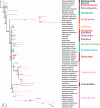Mitochondrial Architecture Rearrangements Produce Asymmetrical Nonadaptive Mutational Pressures That Subvert the Phylogenetic Reconstruction in Isopoda
- PMID: 31192351
- PMCID: PMC6601869
- DOI: 10.1093/gbe/evz121
Mitochondrial Architecture Rearrangements Produce Asymmetrical Nonadaptive Mutational Pressures That Subvert the Phylogenetic Reconstruction in Isopoda
Abstract
The phylogeny of Isopoda, a speciose order of crustaceans, remains unresolved, with different data sets (morphological, nuclear, mitochondrial) often producing starkly incongruent phylogenetic hypotheses. We hypothesized that extreme diversity in their life histories might be causing compositional heterogeneity/heterotachy in their mitochondrial genomes, and compromising the phylogenetic reconstruction. We tested the effects of different data sets (mitochondrial, nuclear, nucleotides, amino acids, concatenated genes, individual genes, gene orders), phylogenetic algorithms (assuming data homogeneity, heterogeneity, and heterotachy), and partitioning; and found that almost all of them produced unique topologies. As we also found that mitogenomes of Asellota and two Cymothoida families (Cymothoidae and Corallanidae) possess inversed base (GC) skew patterns in comparison to other isopods, we concluded that inverted skews cause long-branch attraction phylogenetic artifacts between these taxa. These asymmetrical skews are most likely driven by multiple independent inversions of origin of replication (i.e., nonadaptive mutational pressures). Although the PhyloBayes CAT-GTR algorithm managed to attenuate some of these artifacts (and outperform partitioning), mitochondrial data have limited applicability for reconstructing the phylogeny of Isopoda. Regardless of this, our analyses allowed us to propose solutions to some unresolved phylogenetic debates, and support Asellota are the most likely candidate for the basal isopod branch. As our findings show that architectural rearrangements might produce major compositional biases even on relatively short evolutionary timescales, the implications are that proving the suitability of data via composition skew analyses should be a prerequisite for every study that aims to use mitochondrial data for phylogenetic reconstruction, even among closely related taxa.
Keywords: Cymothoida; GC skew; base composition skew; compositional heterogeneity; mitochondrial phylogenomics; replication origin inversion.
© The Author(s) 2019. Published by Oxford University Press on behalf of the Society for Molecular Biology and Evolution.
Figures






Similar articles
-
Architectural instability, inverted skews and mitochondrial phylogenomics of Isopoda: outgroup choice affects the long-branch attraction artefacts.R Soc Open Sci. 2020 Feb 5;7(2):191887. doi: 10.1098/rsos.191887. eCollection 2020 Feb. R Soc Open Sci. 2020. PMID: 32257344 Free PMC article.
-
Evolutionary history of inversions in directional mutational pressures in crustacean mitochondrial genomes: Implications for evolutionary studies.Mol Phylogenet Evol. 2021 Nov;164:107288. doi: 10.1016/j.ympev.2021.107288. Epub 2021 Aug 5. Mol Phylogenet Evol. 2021. PMID: 34365015
-
Basal position of two new complete mitochondrial genomes of parasitic Cymothoida (Crustacea: Isopoda) challenges the monophyly of the suborder and phylogeny of the entire order.Parasit Vectors. 2018 Dec 10;11(1):628. doi: 10.1186/s13071-018-3162-4. Parasit Vectors. 2018. PMID: 30526651 Free PMC article.
-
The complete mitochondrial genome of Cymothoa indica has a highly rearranged gene order and clusters at the very base of the Isopoda clade.PLoS One. 2018 Sep 4;13(9):e0203089. doi: 10.1371/journal.pone.0203089. eCollection 2018. PLoS One. 2018. PMID: 30180209 Free PMC article.
-
Inverted base composition skews and discontinuous mitochondrial genome architecture evolution in the Enoplea (Nematoda).BMC Genomics. 2022 May 18;23(1):376. doi: 10.1186/s12864-022-08607-4. BMC Genomics. 2022. PMID: 35585506 Free PMC article.
Cited by
-
Comparative Mitogenome Analyses Uncover Mitogenome Features and Phylogenetic Implications of the Parrotfishes (Perciformes: Scaridae).Biology (Basel). 2023 Mar 7;12(3):410. doi: 10.3390/biology12030410. Biology (Basel). 2023. PMID: 36979102 Free PMC article.
-
Mitochondrial phylogenomics of Acanthocephala: nucleotide alignments produce long-branch attraction artefacts.Parasit Vectors. 2022 Oct 19;15(1):376. doi: 10.1186/s13071-022-05488-0. Parasit Vectors. 2022. PMID: 36261865 Free PMC article.
-
The mitochondrial genome of Bottapotamon fukienense (Brachiura: Potamidae) is fragmented into two chromosomes.BMC Genomics. 2024 Aug 2;25(1):755. doi: 10.1186/s12864-024-10657-9. BMC Genomics. 2024. PMID: 39095713 Free PMC article.
-
The complete mitochondrial genomes of Paradiplozoon yarkandense and Paradiplozoon homoion confirm that Diplozoidae evolve at an elevated rate.Parasit Vectors. 2022 Apr 27;15(1):149. doi: 10.1186/s13071-022-05275-x. Parasit Vectors. 2022. PMID: 35477556 Free PMC article.
-
Evolutionary timescale of chalcidoid wasps inferred from over one hundred mitochondrial genomes.Zool Res. 2023 May 18;44(3):467-482. doi: 10.24272/j.issn.2095-8137.2022.379. Zool Res. 2023. PMID: 36994537 Free PMC article.
References
-
- Baele G, Raes J, Van De PY, Vansteelandt S.. 2006. An improved statistical method for detecting heterotachy in nucleotide sequences. Mol Biol Evol. 23(7):1397–1405. - PubMed
-
- Ballard JWO, Whitlock MC.. 2004. The incomplete natural history of mitochondria. Mol Ecol. 13(4):729–744. - PubMed
-
- Bernt M, Braband A, Schierwater B, Stadler PF.. 2013. Genetic aspects of mitochondrial genome evolution. Mol Phylogenet Evol. 69(2):328–338. - PubMed
-
- Boore JL. 2006. The use of genome-level characters for phylogenetic reconstruction. Trends Ecol Evol. 21(8):439–446. - PubMed
Publication types
MeSH terms
LinkOut - more resources
Full Text Sources
Research Materials
Miscellaneous

